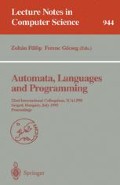Abstract
In this paper we break a 10-year's standing public key cryptosystem, Finite Automata Public Key Cryptosystem(FAPKC for short). The security of FAPKC was mainly based on the difficulty of finding a special common left factor of two given matrix polynomials. We prove a simple but previously unknown property of the input-memory finite automata. By this property, we reduce the basis of the FAPKC's security to the same problem in module matrix polynomial rings. The problem turns out to be easily solved. Hence, we can break FAPKC by constructing decryption automata from the encryption automaton (public key). We describe a modification of FAPKC which can resist above attack.
Preview
Unable to display preview. Download preview PDF.
References
F. Bao, “Limited error-propagation, self-synchronization and finite input memory FPSMs as weak inverses”, in Advances in Chinese Computer Science, Vol. 3, World Scientific, Singapore, 1991, pp. 1–24.
F. Bao, Y. Igarashi, “A randomized algorithm to finite automata public key cryptosystem”, in Proc. of ISAAC'94, LNCS 834, Springer-Verlag, 1994, pp. 678–686.
F. Bao, Y. Igarashi, X. Yu, “Some results on the decomposability of weakly invertible finite automata”, IPSJ Technical Report, 94-AL, November, 1994, pp. 17–24.
E. Berlekamp, “Factoring polynomials over large finite field”, Math. Comp. Vol. 24, 1970, pp. 713–735.
S. Chen, “On the structure of finite automata of which M' is an (weak) inverse with delay Τ”, J. of Computer Science and Technology, Vol. 1, No. 2, 1986, pp. 54–59.
S. Chen, “On the structures of (weak) inverses of an (weakly) invertible finite automata”, J. of Computer Science and Technology, Vol. 1, No. 3, 1986, pp. 92–100.
S. Chen, R. Tao, “The structure of weak inverses of a finite automaton with bounded error propagation”, Kexue Tongbao, Vol. 32, No. 10, 1987, pp. 713–714.
S. Even, “Generalized automata and their information losslessness”, in Switching Circuit Theory and Logic Design, 1962, pp. 144–147.
S. Even, “On Information lossless automata of finite order”, IEEE Trans. on Electric Computer, Vol. 14, No. 4, 1965, pp. 561–569.
I. Gohberg, P. Lancaster, L. Rodman, Matrix Polynomials, Academic Press, New York.
D. A. Huffman, “Canonical forms for information-lossless finite-state logic machines”, IRE Trans. on Circuit Theory, Vol. CT-6, Special Supplements, May, 1959, pp. 41–59.
J. Li, X. Gao, “Realization of finite automata public key cryptosystem and digital signature”, in Proc. of the Second National Conference on Cryptography, CRYPTO-CHINA'92, pp. 110–115. (in Chinese)
J. L. Massey, M. K. Sain, “Inverse of linear sequential circuits”, IEEE Trans. on Computers, Vol. 17, No. 4, 1968, pp. 330–337.
J. L. Massey, A. Gubser, A. Fisger, et al., “A selfsynchronizing digital scrambler for cryptographic protection of data”, in Proc. of International Zurich Seminar on Digital Communications, March, 1984.
R. R. Olson, “A note on feedforward inverses for linear sequential circuits”, IEEE Trans. on Computers, Vol. 19, No. 12, 1970, pp. 1216–1221.
A. Salomaa, Public-Key Cryptography, EATCS Monographs on Theoretical Computer Science, Vol. 23, Springer-Verlag, 1990.
R. Tao, Invertibility of Finite Automata, Science Press, 1979, Beijing. (in Chinese)
R. Tao, “On the relation between bounded error propagation and feedforward inverse”, Kexue Tongbao, Vol. 27, No. 7, 1982, pp. 406–408. (in Chinese)
R. Tao, “On the structure of feedforward inverse”, Science in China, A, Vol. 26, No. 12, 1983, pp. 1073–1078. (in Chinese)
R. Tao, S. Chen, “Finite automata public key cryptosystem and digital signature”, Computer Acta, Vol. 8, No. 6, 1985, pp. 401–409. (in Chinese)
R. Tao, S. Chen, “Two varieties of finite automata public key cryptosystem and digital signature”, J. of Computer Science and Technology, Vol. 1, No. 1, pp. 9–18.
R. Tao, “Invertibility of linear finite automata over a ring”, in Proc. of ICALP'88, LNCS 317, Springer-Verlag, 1988, pp. 489–501.
R. Tao, S. Chen, “An implementation of identity-based cryptosystems and signature schemes by finite automaton public key cryptosystems”, in Proc. of the Second National Conference on Cryptography, CRYPTO-CHINA'92, pp. 87–104. (in Chinese)
H. Zhang, Z. Qin, et al., “The software implementation of FA public key cryptosystem”, in Proc. of the Second National Conference on Cryptography, CRYPTO-CHINA'92, pp. 105–109. (in Chinese)
X. Zhu, “On the structure of binary feedforward inverses with delay 2”, J. of Computer Science and Technology, Vol. 4, No. 2, 1989, pp. 163–171.
Author information
Authors and Affiliations
Editor information
Rights and permissions
Copyright information
© 1995 Springer-Verlag Berlin Heidelberg
About this paper
Cite this paper
Bao, F., Igarashi, Y. (1995). Break Finite Automata Public Key Cryptosystem. In: Fülöp, Z., Gécseg, F. (eds) Automata, Languages and Programming. ICALP 1995. Lecture Notes in Computer Science, vol 944. Springer, Berlin, Heidelberg. https://doi.org/10.1007/3-540-60084-1_70
Download citation
DOI: https://doi.org/10.1007/3-540-60084-1_70
Published:
Publisher Name: Springer, Berlin, Heidelberg
Print ISBN: 978-3-540-60084-8
Online ISBN: 978-3-540-49425-6
eBook Packages: Springer Book Archive

